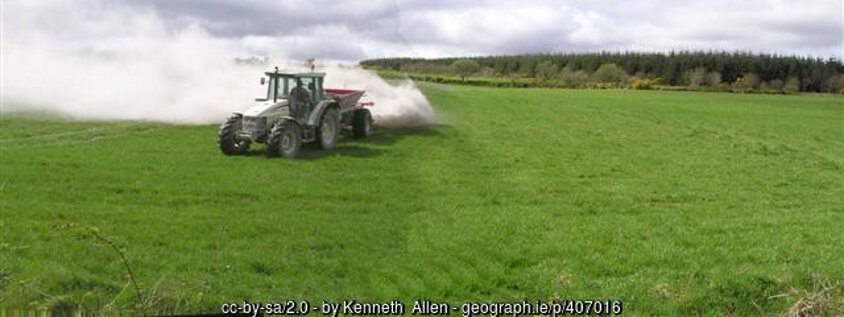I have come across this question very often: What is the difference between calcitic lime, dolomitic lime, hydrated lime, granulated lime and gypsum? They are definitely not the same thing and should never be used interchangeably. There is a reason why a specific product is recommended in a specific context.
Lime and gypsum are broadly grouped as they are calcium-containing minerals which are used for soil amendment on agricultural soils.
First, a note on how effective a specific source of lime is
There are two things that need to be considered in understanding the effectiveness of a specific lime source: 1) neutralising value and 2) fineness. The neutralising value gives an indication of how effective the lime will be at neutralising soil acidity, i.e. increasing soil pH. Ideally the neutralising value of lime should be greater than 95. The fineness gives an idea of the distribution of particle sizes of the lime. The finer the particles, and the greater the proportion of finer particles, the more effective the lime will be.
A third factor, which will be discussed in greater detail below, is the mineral content of the lime in terms of calcium and magnesium levels.
Lime vs gypsum
Let us start with the easiest distinction. Lime is a carbonate, oxide or hydroxide of calcium. It is used to increase soil pH and provide calcium ions in the soil. Gypsum is calcium sulphate. It is also used to provide calcium ions in the soil, but does not have the effect of increasing soil pH. Gypsum is in fact a neutral salt, and therefore is used on soils with pH’s of greater than 7. It is also used to improve soil sulphur levels.
Calcitic vs dolomitic lime
Calcitic and dolomitic lime are very similar in that they are calcium carbonate based. They are also used for similar purposes, i.e. to neutralise soil acidity, and to add calcium ions to the soil. There is one significant difference though. Dolomitic lime contains magnesium, whereas calcitic lime does not. This is an important distinction, as certain soils require additional magnesium, and other soils would be harmed through the addition of magnesium. It is important that the correct lime is used for the correct context.
Quick lime
You may also come across quick (also called burnt) lime. This is calcium oxide. It is more concentrated than calcitic lime, but is unpleasant to handle, so is very seldom used in agriculture.
Hydrated lime
Hydrated lime, also known as slaked lime, is calcium hydroxide, as opposed to calcitic and dolomitic lime. It has a higher neutralising value than calciltic lime, but there are some challenges associated with using it.
A note on hydrated lime
I found a document discussing hydrated lime from a perspective of whether it can be used on organic farms in the USA. Their conclusion was that it cannot be used as it is a synthetic fertiliser.
Some of the comments that came up about the negatives of using it are that it:
- is a corrosive material, and is very unpleasant for people to handle;
- is corrosive towards plants;
- can potentially directly harm soil micro-organisms, although there is no evidence on this;
- raises the pH of the soil too quickly, which can potentially have a negative effect on soil life.
The positive perspective on using it is that it raises the pH quicker than calcitic lime, which is positive purely from a soil fertility perspective.
For these reasons, I would advise farmers to rather use other sources of lime
Granulated lime
Granulated lime has become a popular product. Basically it is just lime that has been finely ground and made into a pelleted form. This has two advantages. Firstly, it is much easier to handle and spread than other forms of lime. Secondly, the particle fineness is much lower than other forms of lime, and therefore it reacts much quicker in the soil.
A note on granulated lime
As wonderful as this sounds, it usually comes with a hefty price tag, often costing about ten times more than normal lime. This is probably why it is also often quoted as being ten times more effective, and therefore you would only need to use a tenth of the recommended rate of normal lime. When considering whether to use granulated lime, the question just needs to be asked: what is the goal of applying lime? If the goal is to purely raise the pH, then granulated lime is effective at doing this. If the goal also includes adding calcium to the soil, building soil calcium levels and increasing calcium base saturation percentage, then I would not recommend granulated lime. Granulated lime does not contain any more calcium than normal lime. If you apply ten times less granulated lime than you would normal lime, then you will be applying ten times less calcium. Keep this in mind before getting caught up in the marketing buzz of granulated lime.
Conclusion
The usefulness of each form of lime is relative to the context within which it is going to be used, and the goal of applying it. Understanding the difference between types of lime is important in using the correct form at the correct time.
Resources
http://www.bvsde.paho.org/bvsacd/cd27/hydroxide-crops.pdf – Accessed 15 November 2018
Agricultural_uses_of_lime_and_gypsum.pdf – Accessed 19 March 2019
http://www.ccmaknowledgebase.vic.gov.au/shkb/brown_book/23_Lime_Comparison.htm – Accessed 19 March 2019
https://www.dpi.nsw.gov.au/agriculture/soils/acidity/publications/best-lime – Accessed 20 March 2019
- A carbon footprint assessment for pasture-based dairy farming systems in South Africa - 2024-02-07
- What progress have farms participating with Trace & Save made over the past 10 years? - 2023-09-06
- Carbon footprint reduction over time: Lessons from pasture-based dairy farms in South Africa - 2023-09-04

